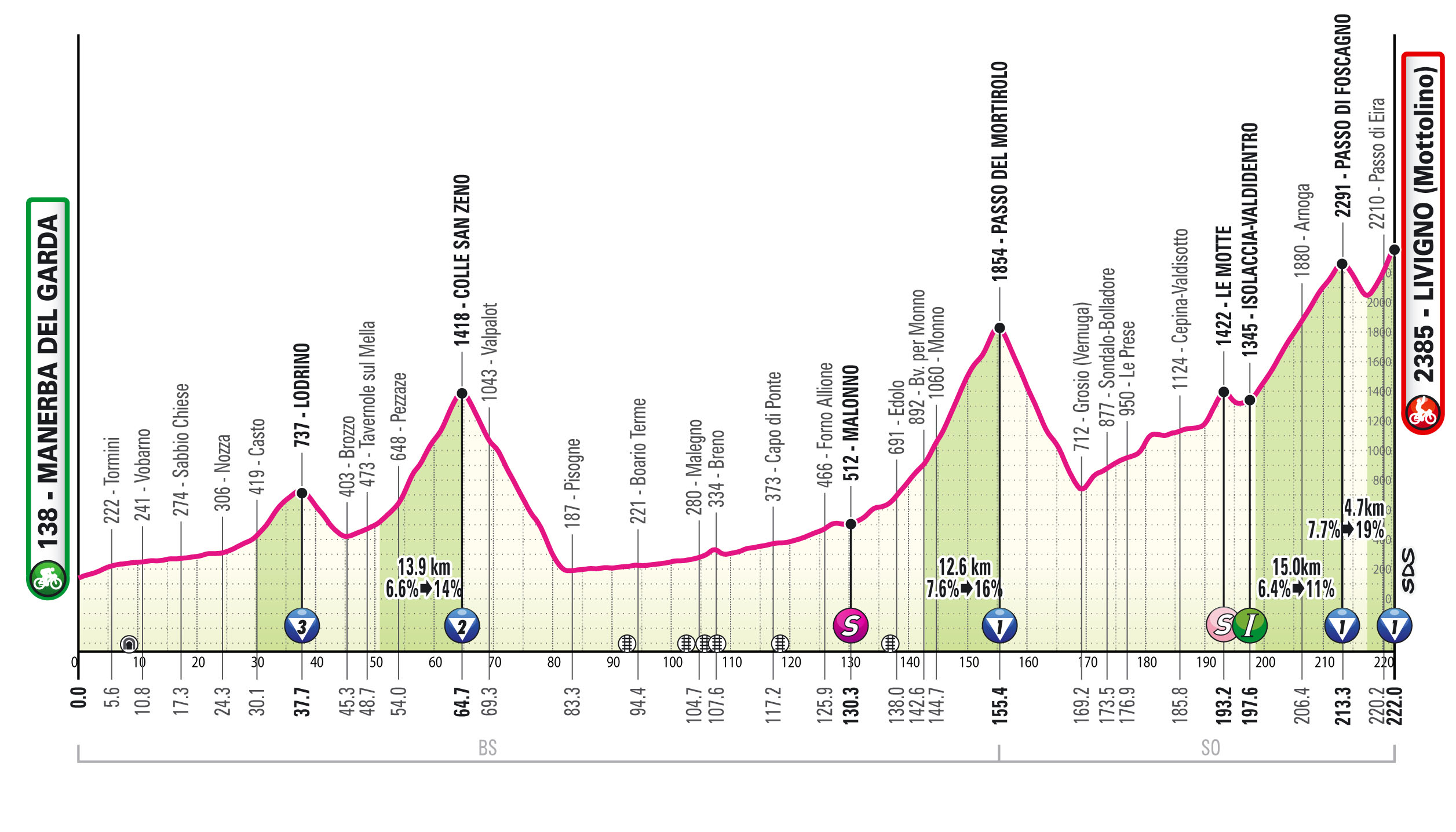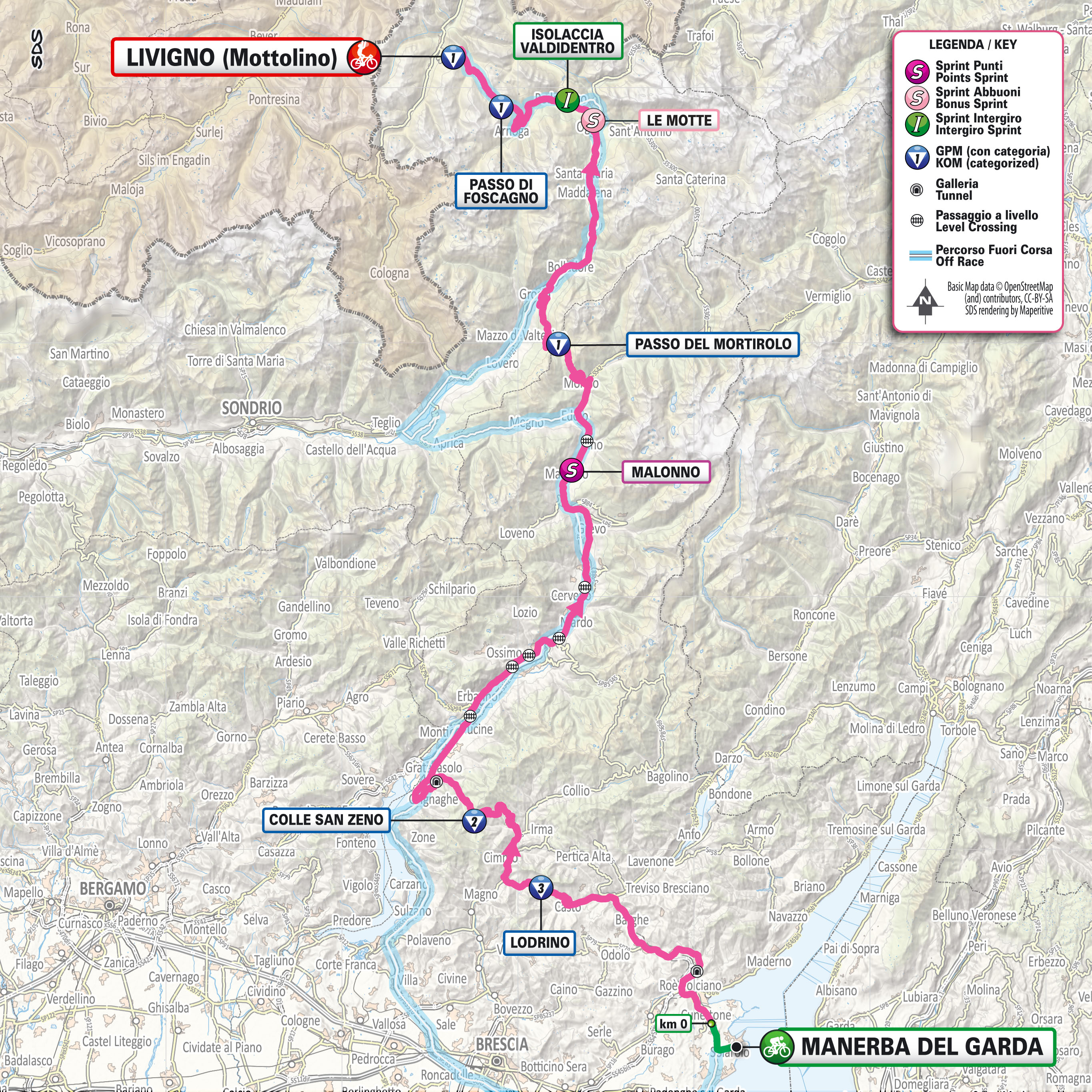

Tadej Pogačar extended his lead at the Giro d’Italia to 3:41 on Geraint Thomas (Ineos Grenadiers) and 3:56 on Daniel Martínez (Bora-Hansgrohe) after the time trial but even he remained cautious and respectful of Sunday’s stage to Livigno, such is the difficulty of the the stage.
Pogačar described the 222 km stage over the Mortirolo and then up to the 2,385 metre thin air high in the Alps as the queen stage of the 2024 race.
“The stage to Livigno is really a monstrous ride,” Pogačar told Eurosport earlier in the Giro.
“We're going to see big differences there. It will be one of the toughest rides we have ever done, looking at the distance and elevation gain.”
“It's the queen stage. We probably want to go for the stage but it depends on the breakaway and what others want to do. We should focus on our own race, and it should all be okay,” Pogačar said on Saturday.
He is right to be cautious and treat the stage with respect.
The fifteenth stage has 5,400 metres of elevation gain, starting at the edge of Lake Garda in Manerba del Garda and then climbing into the Alps behind Brecia to reach Livigno and the border with Switzerland well above two thousands metres.
Late route changes meant the loss of climbs to Aprica and the Forcola di Livigno but RCS Sport added by adding the terrible Mortirolo and Passo di Foscagno before the mountain finish at Mottolino, overlooking the valley resort and border town of Livigno.
The change from a big-gear, power time trial on flat roads to the rarified air and long mountain climbs of the Alps will be brutal.
It will be a day of survival in the gruppetto but also amongst the GC riders and their key teammates. If one of the podium contenders or even Pogačar have a bad day, they could lose minutes and far more than they have lost so far in time trials and early mountain finish.
A race within the race

There will surely be a race within the race, as some brave souls, some of the best climbers out of the GC battle, try to escape to fight for the stage victory.
Trying to ruin their day of glory will be Pogačar, his UAE Team Emirates squad, Ineos Grenadiers and perhaps Antonio Tieri’s Bahrain Victorious team, as they look for an opportunity of another stage victory for the maglia rosa or a chance to improve their podium positions.
Martinez will surely try to pull black time after his poor time trial, while Thymen Arensman, now up to sixth overall, at 6:30, but only a minute down on Tiberi, will surely hope to continue his upwards rise after a difficult start to the Giro.
Esteban Chaves (EF Education-EasyPost), Juan Pedro López (Lidl-Trek), Valentin Paret-Peintre (Decathlon AG2R), talented young Italian Davide Piganzoli (Polti Kometa) and others will surely try to go in the break and so jump up the GC in the constant game of snakes and ladders. Other climbers will be looking for the singular goal of victory.
The stage is a real test of compiling ability and determination.
The opening 30 kilometres are virtually flat but then Lodrino climb is a perfect place to make a serious move. The 13.9km, 6.6% Colle San Zeno comes soon after and will surely see the break establish and reveal who has to chase on the front of the peloton.
A long valley section offers some respite as the race heads north into the Alps beyond Brescia but the final 100km are terrible.
Immediately after points have been awarded for the Maglia Ciclamino in Malonno, the serious climbing begins. The Passo del Mortirolo (12.6 km at 7.6%) starts with 80 km to go. It climbs for nine kilometres at 7.9%, eases briefly and then kicks up again at 9.6% for the final three kilometres.
This climb has been included in the Tour of Italy route eleven times and always hurts the riders. In 2022 Jan Hirt won ahead of Thymen Arensman and eventual overall winner Jai Hindley.
There is a steep descent off the Mortirolo and then the stage begins a gradual but constant climb to Livigno.
The Passo di Foscagno (15 km at 6.4%) starts after the second intermediate sprint of the day 25 kilometres from the finish, but the road climbs 600 metres in the 30km of valley roads.
The Passo di Foscagno climbs to a height of 2,291 metres and is the fourth climb of the day. It is followed by a brief descent and then Passo di Eira (4.7 km at 7.7%) climbs above Livigno to the Mottolino ski area. The dirt track has been asphalted for the Giro d’Italia stage finish, with one steep section at 19%!
The altitude can always cause problems as it reduces the oxygen available to the riders. Some handle the thin air better than others and experience to deal with the suffering above 2,000 is often vital.
When the Giro d’Italia visited Livigno in 2005, Ivan Basso cracked and crashed out of contention due to a stomach problem. If any one went especially deep in the Lake Garda time trial, then they could pay a similar price for it on Sunday.
The 2024 Giro d’Italia may include 20% less climbing than the 2023 race but Sunday’s stage is a real ‘tappone’ as the Italians say. Fortunately the weather should be dry and cool. But only before rain and cold arrives in northern Italy for the third week of the Giro.
Anyone looking for some mountain glory is advised to attack on the road Livigno while they can.
Get unlimited access to all of our coverage of the Giro d'Italia- including journalists reporting, breaking news and analysis on the ground from every stage of the race as it happens and more. Find out more.
Stage 15 Sprints
- Lodrino (cat. 3), km. 37.7
- Intermediate sprint, km. 130.3
- Time bonus sprint, km. 193.2
- Intergiro bonus sprint, km. 197.6
Stage 15 Mountains
- Colle San Zeno (cat. 2), km. 64.7
- Passo del Mortirolo (cat. 1), km. 155.4
- Passo di Foscagno (cat. 1), km. 213.3
- Finish: Livigno (cat. 1), km. 222







